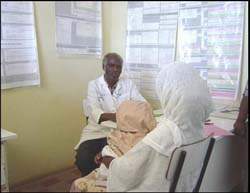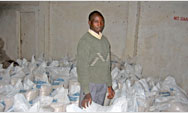 | |  |
 |
 |
USAID Information:
External Links:
|
|
 |
 |
|
You are here » Home » Telling Our Story
Case Study
Eritrea improves immunization from among the worst to the best with USAID help
Saving the Lives of Children in Eritrea
Challenge
Having endured a thirty year struggle for independence and a recent border skirmish, Eritrea’s health system was inadequate with poor facilities, and lacking both supplies and skilled healthcare staff. In 1995, just 41% of children 12-23 months were fully vaccinated and 38% had received no vaccinations at all. Infant and child mortality rates were 72 and 136 per 1000, respectively.

Photo: USAID/Eritrea
A woman and her child receive IMCI counseling from a trained practitioner.
In just seven years, Eritrea has improved its immunization coverage from among the worst to among the best in the developing world.
Initiative
USAID provides approximately $2.5 million annually to improve maternal and child health in Eritrea. As part of this larger assistance program, the Ministry of Health (MoH) identified several key areas in which USAID could make a contribution to improving immunization and child health. USAID, through a $2.3 million grant, helped to supply both equipment and training in the implementation and management of an expanded program for immunization. USAID also assisted the MoH to begin the implementation of integrated management of childhood illness (IMCI). With USAID help, the MoH conducted a baseline survey to determine the ability of health facilities and health workers to implement IMCI. Over 500 health care providers at all levels of the health care system were trained in IMCI case management.
Results
A follow-up assessment of health facilities was completed in 2003 and showed tremendous improvement in the availability of equipment and drugs necessary to implement IMCI. Assessment practices of providers also improved - checking for the three danger signs increased from 0% to 37%; checking for cough, diarrhea and fever increased from 25% to 89%; and checking immunization status increased from 19% to 58%. Immunization coverage increased in fully vaccinated children 12-23 months from 41% in 1995 to 76% in 2002. According to the Demographic and Health Survey (DHS), this level of immunization coverage is the highest among sub-Saharan African countries in the past five years and the rate of improvement - 83% over 7 years - is remarkable at a time when immunization coverage has decreased in Africa on average. The 2002 DHS also showed remarkable progress in the reduction of infant mortality - from 72 per 1000 children in 1995 to 48 per 1000 children in 2002; and under-five mortality - from 136 per 1000 children to 93 per 1000 children - during the same period. This pace of decline is among the fastest experienced in any developing country. Print-friendly version of this page (257kb - PDF) Back to Top ^ | 



